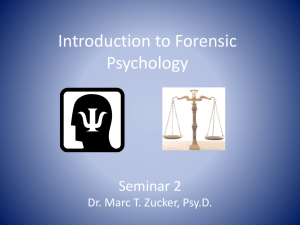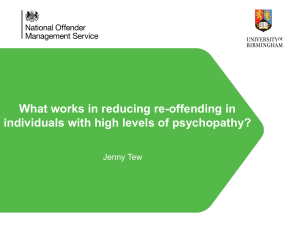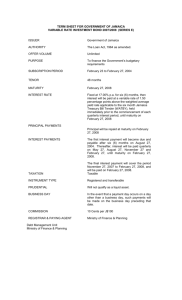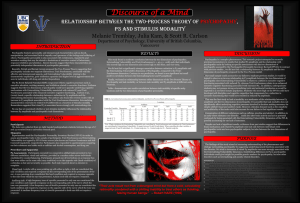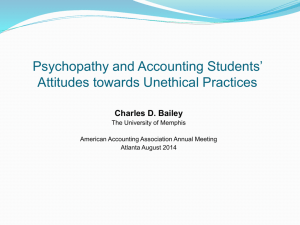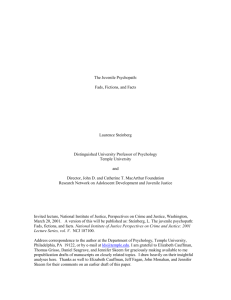The Juvenile Psychopath:
advertisement
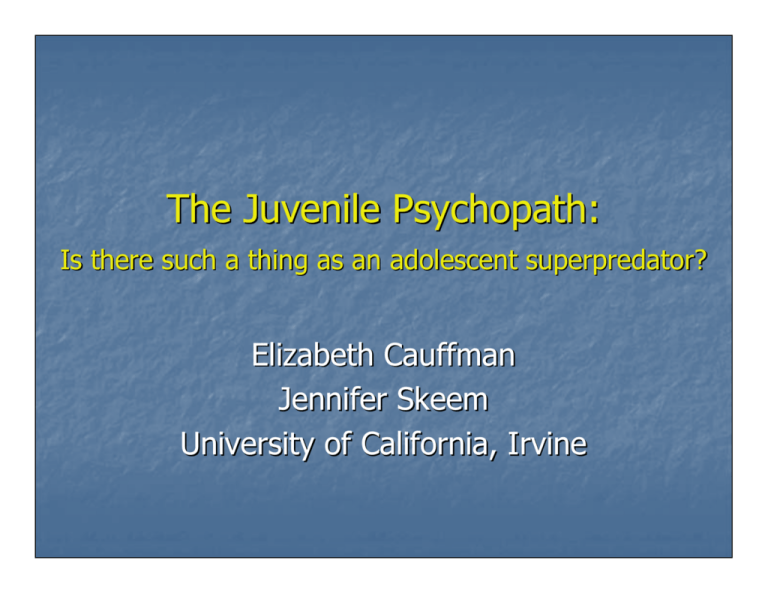
The Juvenile Psychopath: Is there such a thing as an adolescent superpredator? Elizabeth Cauffman Jennifer Skeem University of California, Irvine Faces of Psychopathy Psychopaths… David Berkowitz …Are charismatic …Lack a conscience …Manipulate others …Engage in risky & impulsive behaviors …Lack concern about consequences to others …Form only shallow & transient relationships Ted Bundy Measuring Psychopathy in Adults Psychopathy provides more specificity than Antisocial Personality Disorder. As a personality disorder, psychopathy is considered highly stable. The “gold standard” measure of psychopathy is the Psychopathy Checklist: Revised (PCL:R), which has been found to predict future violent behavior among adult male offenders. (r = approx. .30 for violent recidivism) Developmental Concerns Adolescence is a time of dramatic psychosocial change. Personality disorders should not be diagnosed during this time period (since personality has not yet stabilized). PCL:YV, as a downward extension of the PCL:R, has not been validated among adolescents. Legal Decisions Based on Juvenile Psychopathy Six U.S. and Canadian transfer cases US v. Doe (2000): Upward transfer PCL:R (27) offered “as the single best predictor of a person’s future criminal recidivism, violent recidivism, and failure to respond to treatment” These juvenile acts “reflected a psychopathic personality and not mere immaturity” Legal Decisions Based on Juvenile Psychopathy Issue of treatment amenability “One who has been found not amenable for treatment as a sexual psychopath can hardly expect to convince us that he should have been ‘treated’ in a juvenile institution” State v. Pentland (1986) Psychopathic cannot be treated People v. Haynes (1993), State v. Pentland, (1986); see also Matter of DTH (1997), Morgan v. State (1977), Matter of Fox (1981) Adolescent Psychopath? Cody Posey Received a score of 19 on the PCL:YV At 14 years of age, committed a triple homicide (killed his father, stepmother, and stepsister) Deemed a psychopath and untreatable by the adolescent psychiatrist Judge sentenced Cody as a juvenile "The court is not convinced that the respondent has antisocial personality traits to the extent that would make him not amendable to treatment or rehabilitation." The “Downward Extension” of Psychopathy to Adolescence The PCL:YV is a slight modification of the PCL:R. Contains 20 criteria Scores above cut-off of 30 are considered “psychopathic” Composed of two related, but distinct, factors: Factor 1 – Interpersonal / Affective Factor 2 – Behavioral Items from the PCL-YV Impression Management Grandiose sense of selfworth Pathological lying Conning/manipulative Lack of remorse or guilt Shallow affect Callous/Lack of empathy Failure to accept responsibility for actions Impersonal sexual behavior Stimulation Seeking Parasitic lifestyle Poor anger control Early behavior problems Lacks goals Impulsivity Irresponsibility Juvenile delinquency Serious violation of conditional release Criminal versatility Unstable interpersonal relationships Current Factor Structure Factor 1 - Arrogant and Deceitful Interpersonal Style Impression Management Grandiose Sense of SelfWorth Pathological Lying Manipulation for Personal Gain Factor 2 - Deficient Affective Experience Lack of Remorse Shallow Affect Callous/Lack of Empathy Failure to Accept Responsibility Factor 3 - Impulsive and Irresponsible Behavioral Style Stimulation Seeking Parasitic Lifestyle Lacks Goals Impulsivity Irresponsibility Factor 4 – Antisocial Behavior Poor Anger Control Early Problem Behaviors Juvenile Delinquency Serious Violations of Conditional Release Criminal Versatility Aims of the Present Study Is psychopathy stable over time? How do changes in psychosocial maturity relate to changes in psychopathy? Study Design ADOLESCENTS 14-17 years ADULTS 26-29 years Sample Size N=202 Sample Size N=134 Non Psychopathic N=101 Psychopathic N=101 Non Psychopathic N=73 Psychopathic N=61 Sample Characteristics Age Ethnicity Black Latino White Other Adolescent (N = 202) 15.8 (.90) Adult (N = 134) 27.5 (1.1) 43% 13% 35% 9% 54% 12% 29% 5% Sample Characteristics Adolescent (N = 202) 4.9 (6.4) Adult (N = 134) 6.2 (8.4) Offense(%) Person 25 50 Property Weapons Drug Procedural 6 3 6 26 5 2 10 9 12.3 14.2 Priors(#) Age 1st Contact Are PCL scores stable over time? Intraclass Correlation Coefficients PCL Total Score 28 .61* 27 .31* 26 .37* 25 .73* 24 .55* 23 Baseline One Month One Year Adults Adolescents .70* Two Year Change Scores PCL Total Score 28 -.28 27 -1.24 26 -2.72 25 .71 24 -.79 23 Baseline One Month One Year Adults Adolescents .85 Two Year Significant interaction F (3) = 4.0, p < .01 How do changes in psychosocial maturity relate to changes in psychopathy? Measures of Psychosocial Maturity Responsibility Psychosocial Maturity Inventory Work Orientation, Self-Reliance, Identity Resistance to Peer Influence (Alpha = .60 /.64) Perspective (Alpha = .84 / .85) Future Outlook Inventory Consideration of Others (Alpha = .75 / .76) (Alpha = .78 /.77) Temperance Self-Control (Alpha = .82 /.81) Age Differences in Maturity Mean Level of Maturity 4.30 3.80 3.30 2.80 2.30 8th Grade 10th Grade 12th Grade Young Adult Adult Cauffman & Steinberg, 2000 Changes in Maturity for Adolescents and Adults Change in Maturity by Age Change in Maturity by Age 0.0 0.4 .066 0.3 Maturity Score Maturity Score -0.1 -0.2 0.2 -0.3 0.1 -0.4 0 14 15 16 17 Age Adolescents 18 19 26 27 28 29 Age Adults 30 31 How do changes in psychosocial maturity relate to changes in psychopathy? Correlations Between Change in Maturity and Change in PCL Scores ADOLESCENTS Baseline to One Year -.27* ADULTS Baseline to One Year -.08 Conclusions Relative to adults, adolescents psychopathy scores are not as stable. There appears to be some change in psychopathy even among adults. Changes in developmental maturity are related to changes in psychopathy for adolescents but not for adults. Thanks to….. Project Coordinators Jennifer Dickman Lisa Spahr Full-Time Data Team Amy Carper Barbara Castor Shawn Ellies Mike Ludwig Adolescent & Adult Interviewers Barbara Castor He Len Chung Matt Didier Shawn Ellies Susan Flamm Margo Gardner Gordon Hodnett Christie Jones Rachel Kalbeitzer Mike Ludwig Sherry Parkinson Andrea Sanders Chris Schreiber Chriscelyn Tussey
